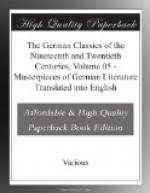Here first prominently unfolds itself the difference in Nature of the forms of Art.
Plastic Art, in the more exact sense of the term, disdains to give Space outwardly to the object, but bears it within itself. This, however, narrows its field; it is compelled, indeed, to display the beauty of the Universe almost in a single point. It must therefore aim immediately at the highest, and can attain complexity only separately and in the strictest exclusion of all conflicting elements. By isolating the purely animal in human nature it succeeds in forming inferior creations too, harmonious and even beautiful, as we are taught by the beauty of numerous Fauns preserved from antiquity; yea, it can, parodying itself like the merry spirit of Nature, reverse its own Ideal, and, for instance, in the extravagance of the Silenic figures, by light and sportive treatment appear freed again from the pressure of matter.
But in all cases it is compelled strictly to isolate the work, in order to make it self-consistent and a world in itself; since for this form of Art there is no higher unity, in which the dissonance of particulars should be melted into harmony.
Painting, on the contrary, in the very extent of its sphere, can better measure itself with the Universe, and create with epic profusion. In an Iliad there is room even for a Thersites; and what does not find a place in the great epic of Nature and History!
Here the Particular scarcely counts anything by itself; the Universe takes its place, and that, which by itself would not be beautiful, becomes so in the harmony of the whole. If in an extensive painting, uniting forms by the allotted space, by light, by shade, by reflection, the highest measure of Beauty were everywhere employed, the result would be the most unnatural monotony; for, as Winckelmann says, the highest idea of Beauty is everywhere one and the same, and scarcely admits of variation. The detail would be preferred to the whole, where, as in every case in which the whole is formed by multiplicity, the detail must be subordinate to it.
[Illustration: THE JUNGFRAU From the Painting by Moritz von Schwind]
In such a work, therefore, a gradation of Beauty must be observed, by which alone the full Beauty concentrated in the focus becomes visible; and from an exaggeration of particulars proceeds an equipoise of the whole. Here, then, the limited and characteristic finds its place; and theory at least should direct the painter, not so much to the narrow space in which the entire Beauty is concentrically collected, as to the characteristic complexity of Nature, through which alone he can impart to an extensive work the full measure of living significance.
Thus thought, among the founders of modern art, the noble Leonardo; thus Raphael, the master of high Beauty, who shunned not to exhibit it in smaller measure, rather than to appear monotonous, lifeless, and unreal—though he understood not only how to produce it, but also how to break up uniformity by variety of expression.




